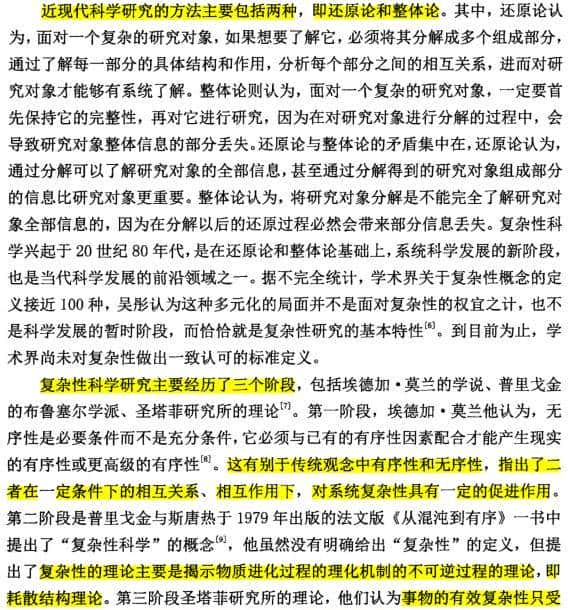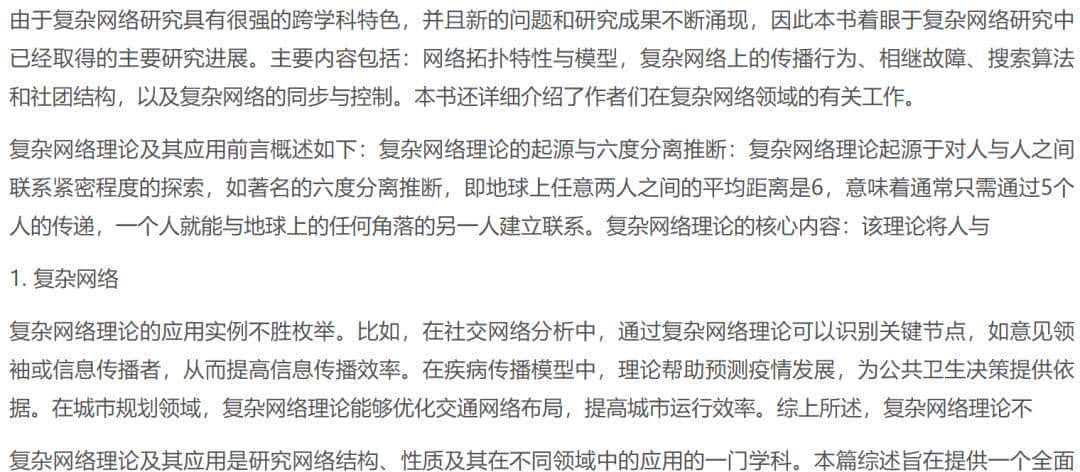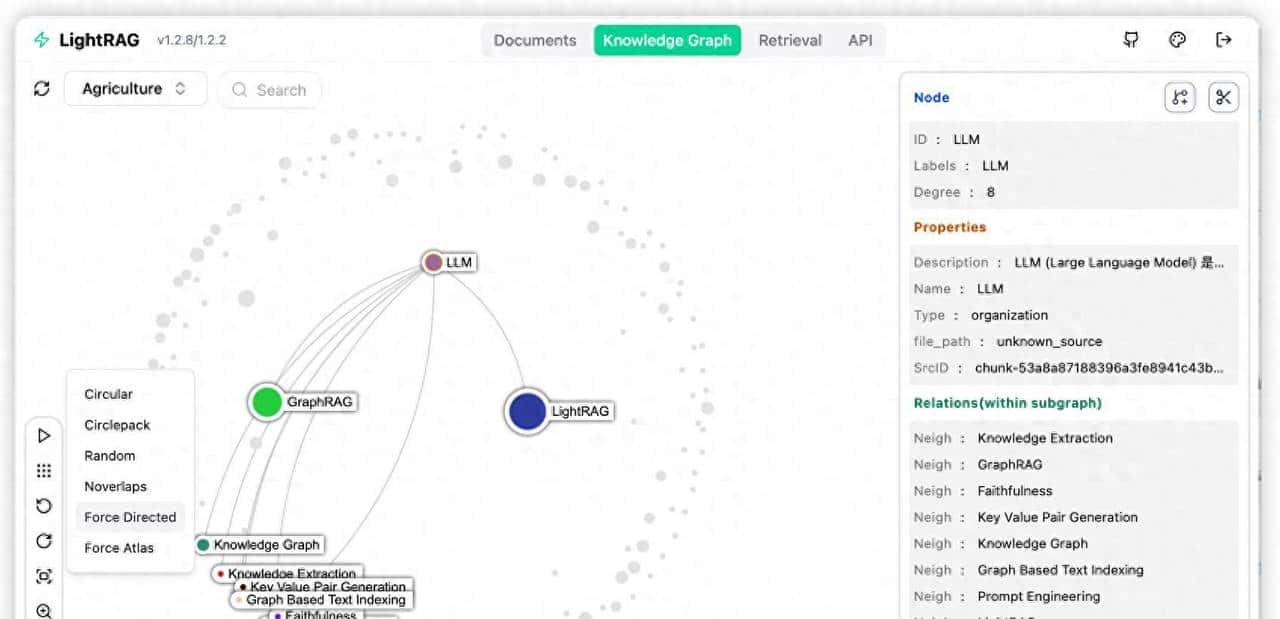
分享兴趣,传播快乐,
增长见闻,留下美好。
亲爱的您,这里是LearingYard学苑!
今天小编为大家带来“精读博士论文《基于复杂网络的电力供应链风险管理研究》2.1复杂网络理论概述(1)”。
欢迎您的访问!
Share interest, spread happiness,
increase knowledge, and leave beautiful.
Dear, this is the LearigYard Academy!
Today, the editor brings the “the 2.1 overview of complex network theory (1) of the doctoral dissertation 'Research on risk management of power supply chain based on complex networks'”.
Welcome to visit!

一、内容摘要(Content summary)
本期推文将从思维导图、精读内容、知识补充三个方面介绍精读博士论文《基于复杂网络的电力供应链风险管理研究》的2.1复杂网络理论概述(1)。
This issue of tweets will introduce the the 2.1 overview of complex network theory (1) of the doctoral dissertation “Research on risk management of power supply chain based on complex networks” from three aspects: mind mapping, intensive reading content, and knowledge supplement.
二、思维导图(Mind Mapping)

三、精读内容(Detailed Reading Content)
在该章节,作者阐述了复杂性的涵义,以及复杂网络的基本概念、测量指标、经典模型和研究现状。本次推文将为大家分析前三部分内容,即:复杂性的涵义、复杂网络的基本概念和测量指标。
In this chapter, the author expounds the meaning of complexity, as well as the basic concepts, measurement indicators, classical models and current research status of complex networks. This tweet will analyze the first three parts for everyone, namely: the meaning of complexity, the basic concepts of complex networks, and measurement indicators.
(一)复杂性涵义(Meaning of complexity)
作者第一阐述了近现代科学研究的两种核心方法论——还原论与整体论的对立与互补关系,并以此为背景引出复杂性科学的兴起与发展。复杂性科学研究的发展主要历经了三个阶段,一是无序性与有序性的协同可促进更高级复杂性,二是耗散结构理论揭示了不可逆进化过程中的理化机制,三是圣塔菲研究所则强调“被冻结的偶然事件”对复杂性的塑造作用,指出历史偶然性会固化为高层次规律。目前,复杂性仍无统必定义,其多元性恰恰反映了该领域的本质特征,即通过跨学科视角研究动态、非线性、涌现性的系统行为。
The author first expounds the opposition and complementarity between the two core methodologies of modern and contemporary scientific research – reductionism and holism, and against this background, introduces the rise and development of complexity science. The development of complexity science research has mainly gone through three stages. The first is that the synergy of disorder and order can promote higher levels of complexity. The second is that the theory of dissipative structure reveals the physicochemical mechanisms in the irreversible evolutionary process. The third is that the Santa Fe Institute emphasizes the shaping role of “frozen accidental events” on complexity, pointing out that historical contingents will solidify into high-level laws. At present, there is no unified definition of complexity. Its diversity precisely reflects the essential feature of this field, that is, the study of dynamic, nonlinear and emergent system behaviors through an interdisciplinary perspective.

(二)复杂网络基本概念(Basic Concepts of Complex Networks)
在该小节,作者第一介绍了复杂网络的定义。复杂网络是研究复杂系统的一种重大方法,其核心关注系统中个体相互关联的拓扑结构,通过分析节点和边的构成模式,揭示系统整体性质与功能。该理论融合自然科学与社会科学的跨学科思想,由Watts和Strogatz提出的小世界网络、Barabási与Albert发现的无标度网络等模型突破传统规则或随机网络的局限,奠定了实际应用基础。
In this section, the author first introduces the definition of complex networks. Complex networks are an important approach to studying complex systems. Their core focus is on the topological structure of the interrelationships among individuals within the system. By analyzing the composition patterns of nodes and edges, they reveal the overall nature and function of the system. This theory integrates interdisciplinary ideas from both natural and social sciences. Models such as the small-world network proposed by Watts and Strogatz and the scale-free network discovered by Barabasi and Albert break through the limitations of traditional rule-based or random networks, laying the foundation for practical applications.
然后,总结了其特征。钱学森进一步归纳其特性包括自组织性、自类似性、吸引子等特征。现实中的神经系统、计算机网络、交通系统、电力网络及供应链等均可建模为复杂网络,例如以节点表明交叉路口、边表明道路,通过平均路径长度、聚集系数等指标量化系统效率或鲁棒性,尤其能识别供应链核心企业或电网关键结构单元的无标度特性。
Then, its characteristics were summarized. Qian Xuesen further summarized its characteristics, including self-organization, self-similarity, attractors and other features. In reality, neural systems, computer networks, transportation systems, power networks, and supply chains can all be modeled as complex networks. For instance, nodes can represent intersections and edges can represent roads. The efficiency or robustness of the system can be quantified through indicators such as average path length and aggregation coefficient, especially for identifying the scale-free characteristics of core enterprises in the supply chain or key structural units in the power grid.

(三)复杂网络测量指标(Complex network measurement indicators)
复杂网络源于图论,通过节点和边描述对象间关系,可分为无向/有向网络、加权/无权网络,其中无向网络边无方向性,有向网络边有方向性,加权网络边具权值而无权网络则无。针对于复杂网络测量指标,作者介绍了度和度分布、平均路径长度、聚类系数、介数。
Complex networks originate from graph theory. They describe the relationships between objects through nodes and edges and can be classified into undirected/directed networks and weighted/unweighted networks. Among them, the edges of undirected networks have no directionality, the edges of directed networks have directionality, the edges of weighted networks have weights, while those of unweighted networks do not. For the measurement indicators of complex networks, the author introduces degree and degree distribution, average path length, clustering coefficient, and betweenness.
第一,作者阐述了复杂网络中节点度的基本概念及其重大性。度表明与节点直接相连的节点数量,度值越高则节点在网络中的枢纽作用越显著。在有向网络中,度进一步分为出度(指向其他节点的边数)和入度(被其他节点指向的边数)。度分布通过概率函数描述网络中不同度值的节点占比。实证研究表明,实际网络(如交通、电力网络)的度分布一般服从幂律分布(无标度网络特性),而非随机网络的泊松分布,这揭示了真实网络中少数枢纽节点占据关键地位的现象。
Firstly, the author expounds the basic concept of node degree in complex networks and its significance. Degree represents the number of nodes directly connected to a node. The higher the degree value, the more significant the hub role of the node in the network. In a directed network, degree is further divided into out-degree (the number of edges pointing to other nodes) and in-degree (the number of edges pointed to by other nodes). The degree distribution describes the proportion of nodes with different degree values in the network through a probability function. Empirical research shows that the degree distribution of actual networks (such as transportation and power networks) usually follows a power-law distribution (a characteristic of scale-free networks), rather than the Poisson distribution of random networks, which reveals the phenomenon that a few hub nodes occupy a key position in real networks.

其次,复杂网络中的平均路径长度和网络直径是衡量网络传输效率的关键指标,分别通过节点间最短路径的平均值和最大值来反映网络的连通性和信息传递效率。连接两个可达节点之间具有最少边数的路径为两个节点的距离。其间的最大距离叫做网络直径,而所有节点对之间距离的平均值被称为平均路径。两者反映网络传输效率:数值越小,效率越高,反之效率越低。
Secondly, the average path length and network diameter in complex networks are key indicators for measuring the transmission efficiency of the network. They respectively reflect the connectivity and information transmission efficiency of the network through the average and maximum values of the shortest paths between nodes. The path with the least number of edges connecting two reachable nodes is the distance between the two nodes. The maximum distance between them is called the network diameter, and the average of the distances between all node pairs is called the average path. Both reflect the efficiency of network transmission: the smaller the value, the higher the efficiency; conversely, the lower the efficiency.

然后,复杂网络中的聚类特征指相邻节点间存在紧密连接的现象,如社交网络中朋友之间互为朋友,聚类系数通过计算节点邻居间的实际连接数与最大可能连接数之比来量化这种紧密程度。
Then, the clustering feature in complex networks refers to the phenomenon of close connections between adjacent nodes, such as friends in social networks being friends with each other. The clustering coefficient quantifies this degree of closeness by calculating the ratio of the actual number of connections between node neighbors to the maximum possible number of connections.

最后,介数是网络分析核心概念,包括节点介数和边介数两类。节点介数是指网络中所有最短路径经过该节点的比例,反映节点对信息流动的控制能力。边介数是指所有最短路径经过该边的比例,表征边在连接不同网络区域中的枢纽作用。高介数的节点或边一般是网络中的关键枢纽,对信息传播效率具有决定性影响。通过优先控制这些高介数要素,可显著提升网络信息管理的覆盖范围和效率。反之,忽视其重大性可能导致信息掌控不全面或成本激增。
Finally, betweenness is a core concept in network analysis, including two types: node betweenness and edge betweenness. The node betweenness refers to the proportion of all the shortest paths in the network passing through this node, reflecting the node's control ability over the flow of information. The edge betweenness refers to the proportion of all shortest paths passing through an edge, characterizing the pivotal role of the edge in connecting different network regions. Nodes or edges with high betweenness are usually key hubs in a network and have a decisive impact on the efficiency of information dissemination. By prioritizing the control of these high-betweenness elements, the coverage and efficiency of network information management can be significantly enhanced. Conversely, neglecting its significance may lead to incomplete information control or a sharp increase in costs.

四、知识补充——复杂网络的应用场景(Knowledge Supplementation – Application Scenarios of Complex Networks)
复杂网络理论起源于对社会连接的探索,现已发展为涵盖网络拓扑特性、传播行为、相继故障、搜索算法、社团结构及同步控制等关键方向的系统性学科。其应用广泛涉及社交网络分析(识别关键节点)、流行病预测、交通优化等领域,通过模型构建与机理分析为实际问题提供解决方案。
Complex network theory originated from the exploration of social connections and has now developed into a systematic discipline covering key directions such as network topological characteristics, propagation behavior, successive failures, search algorithms, community structure, and synchronous control. Its applications are extensive, covering areas such as social network analysis (identifying key nodes), epidemic prediction, and traffic optimization. Through model construction and mechanism analysis, it provides solutions to practical problems.


今天的分享就到这里了,
如果您对文章有独特的想法,
欢迎给我们留言。
让我们相约明天,
祝您今天过得开心快乐!
That's all for today's sharing.
If you have a unique idea about the article,
please leave us a message,
and let us meet tomorrow.
I wish you a nice day!
参考资料:ChatGPT、百度百科
参考文献:
[1] 张晓亮. 基于复杂网络的电力供应链风险管理研究 [D]. 北京: 北京邮电大学, 2023.
本文由LearningYard学苑整理并发出,如有侵权请在后台留言!
文案| Ann
排版| Ann
审核| Whisper
相关文章





